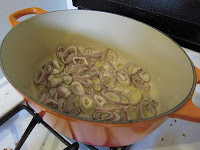We rarely feel that the dish we cook up is the dish the recipe writer cooked up. There is no way to know for certain, of course. But, for some reason, this recipe from Sunset magazine (July 2010) just felt right. Тasted right.
As with many recipes involving tamarind, you start by cutting off a piece of its dried pulp and soaking it in warm water (1/3 cup) for at least 30 minutes. (We bought our tamarind online over two years ago and it shows no signs of decay after being stored in the refrigerator since then.) After it has softened, push as much of it through a sieve as you can, along with the liquid.
Prepare the shallots for later use as garnish by frying (almost deep-frying) them in a large, heavy-bottomed pot (we used a 5-quart dutch oven) in a generous amount of oil. Wait until they get crisp -- at least 12 minutes -- and drain them on paper towels. When done, pour off most of the oil, reserving for later use perhaps.
Starting from oil left over from the shallots, build the soup by cooking garlic for a few seconds, followed by chili paste, broth, a cup of water, fish sauce, sugar, tamarind liquid, and tomatoes. Bring this to a boil and simmer, uncovered, for 5 minutes.
Add cabbage, pineapple, bean sprouts, and shrimp. Cook until the shrimp are cooked. Stir in herbs and chiles. Serve with shallots on top of individual bowls and with lime wedges on the side.
- 3 Tbsp tamarind pulp
- 1 cup vegetable oil (for deep-frying shallots)
- 2 shallots, sliced
- 4 garlic cloves, minced
- 1/2 tsp chili paste (sambal oelek or other)
- 1 qt reduced-sodium chicken broth
- 1 Tbsp fish sauce (Thai or Vietnamese)
- 2 Tbsp sugar
- 2 tomatoes, cut into 1-inch cubes
- 1 cup green cabbage, finely shredded
- 1/4 fresh pineapple, cut into wedges, then into matchsticks
- 2 cups bean sprouts
- 2/3 lb raw shrimp (26-30 per lb), peeled and deveined
- 4 sprigs of cilantro or ripe paddy herb
- 15 Thai basil leaves, torn up
- 2 Thair chiles or other small hot chiles, chopped
- 2 limes, cut into wedges









As with many recipes involving tamarind, you start by cutting off a piece of its dried pulp and soaking it in warm water (1/3 cup) for at least 30 minutes. (We bought our tamarind online over two years ago and it shows no signs of decay after being stored in the refrigerator since then.) After it has softened, push as much of it through a sieve as you can, along with the liquid.
Prepare the shallots for later use as garnish by frying (almost deep-frying) them in a large, heavy-bottomed pot (we used a 5-quart dutch oven) in a generous amount of oil. Wait until they get crisp -- at least 12 minutes -- and drain them on paper towels. When done, pour off most of the oil, reserving for later use perhaps.
Starting from oil left over from the shallots, build the soup by cooking garlic for a few seconds, followed by chili paste, broth, a cup of water, fish sauce, sugar, tamarind liquid, and tomatoes. Bring this to a boil and simmer, uncovered, for 5 minutes.
Add cabbage, pineapple, bean sprouts, and shrimp. Cook until the shrimp are cooked. Stir in herbs and chiles. Serve with shallots on top of individual bowls and with lime wedges on the side.
- 3 Tbsp tamarind pulp
- 1 cup vegetable oil (for deep-frying shallots)
- 2 shallots, sliced
- 4 garlic cloves, minced
- 1/2 tsp chili paste (sambal oelek or other)
- 1 qt reduced-sodium chicken broth
- 1 Tbsp fish sauce (Thai or Vietnamese)
- 2 Tbsp sugar
- 2 tomatoes, cut into 1-inch cubes
- 1 cup green cabbage, finely shredded
- 1/4 fresh pineapple, cut into wedges, then into matchsticks
- 2 cups bean sprouts
- 2/3 lb raw shrimp (26-30 per lb), peeled and deveined
- 4 sprigs of cilantro or ripe paddy herb
- 15 Thai basil leaves, torn up
- 2 Thair chiles or other small hot chiles, chopped
- 2 limes, cut into wedges









